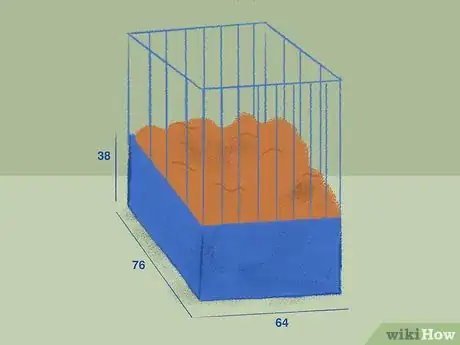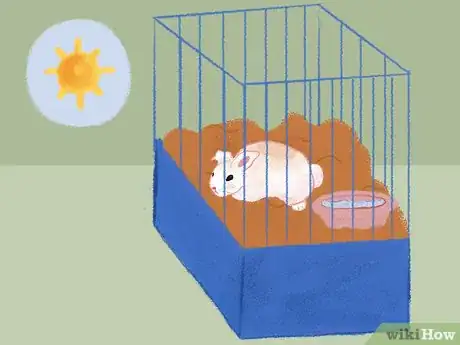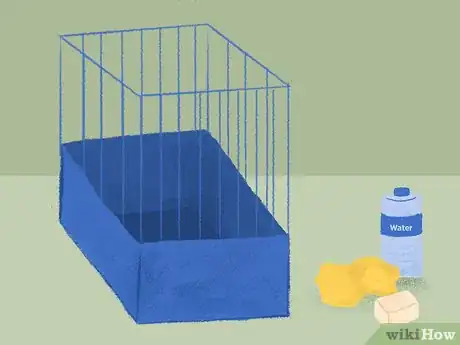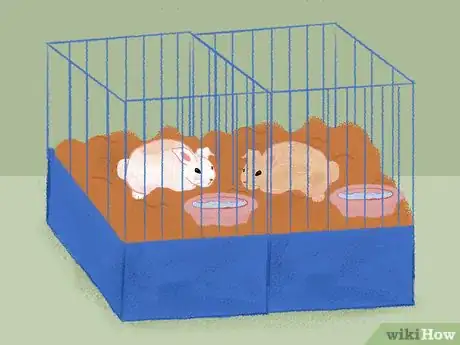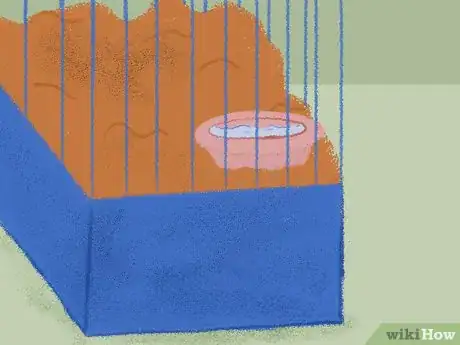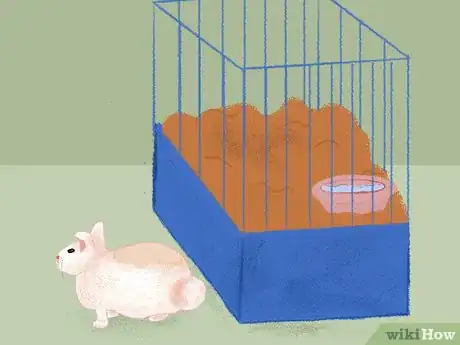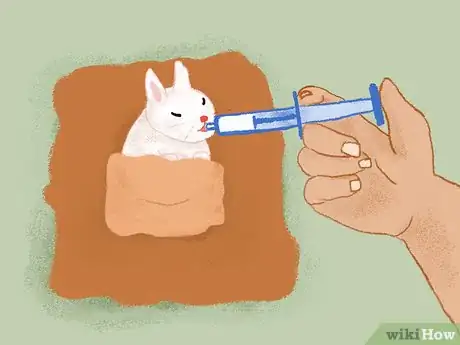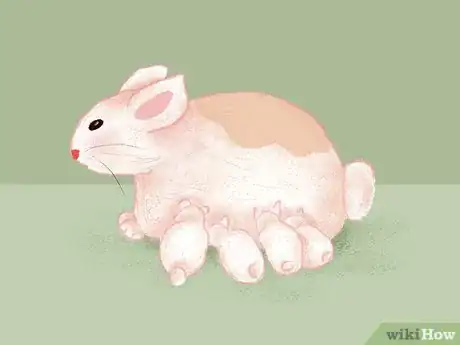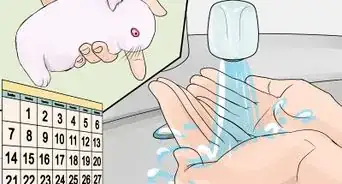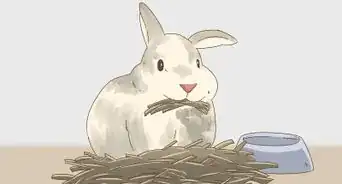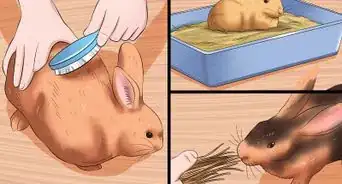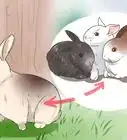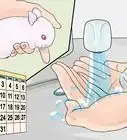This article was co-authored by Pippa Elliott, MRCVS. Dr. Elliott, BVMS, MRCVS is a veterinarian with over 30 years of experience in veterinary surgery and companion animal practice. She graduated from the University of Glasgow in 1987 with a degree in veterinary medicine and surgery. She has worked at the same animal clinic in her hometown for over 20 years.
There are 20 references cited in this article, which can be found at the bottom of the page.
wikiHow marks an article as reader-approved once it receives enough positive feedback. This article received 48 testimonials and 96% of readers who voted found it helpful, earning it our reader-approved status.
This article has been viewed 833,291 times.
Rabbits are renowned for their prodigious reproductive abilities, but like all mommies, female rabbits (also known as “does”) still need lots of care and support to make it to term successfully. Thankfully, there are plenty of things you can do to ensure that your pet rabbit’s pregnancy goes as smoothly as possible. Start by making a hay-filled nest box for your doe where she can prepare to deliver safely and comfortably. Then, see that she’s comfortable and well-fed until she’s ready to give birth, at which point you can begin caring for the litter before making up your mind whether to keep or rehome them.
Steps
Creating a Suitable Birthing Environment
-
1Provide your doe with a space that can comfortably hold her and her young. A pregnant doe can give birth to as many as 14 kits, or baby bunnies, at one time, which means she’ll be needing a good amount of room. It’s recommended that you house your doe in a cage, crate, or hutch that’s a minimum of 25–30 in (64–76 cm) x 15 in (38 cm). This will allow her and her kits to move around, stretch out, and exercise without difficulty.[1]
- If your rabbit doesn’t already have a living space that’s at least 25–30 in (64–76 cm) x 15 in (38 cm), now is a good time to build or invest in a new one.[2]
- Ideally, your doe’s maternity lodging should be at least somewhat private, with as few bright light sources, noisy appliances, or other potentially nerve-wracking distractions in the surrounding area as possible.
-
2Set up a hay-filled nest box inside your doe’s cage. Take a small wooden crate, cardboard box, or similar open container and place it in one corner of the cage. Cover the bottom with 3–6 inches (7.6–15.2 cm) of soft grass hay. Make sure the structure you use is spacious and low enough for your doe to come and go easily. She’ll use this space to lounge around until she’s ready to kindle, or give birth.[3]
- You can also offer your doe other comfortable nest-making materials, such as a layer of old rags or paper towels and scraps of shredded newspaper.
- The nesting materials you put down will also help keep the newborn kits warm, which is critical for their survival.
- If you aren’t sure what size box to use for your pregnant doe, provide multiple boxes of various sizes so it can choose whichever one it wants.
- Rabbits that don’t have a dark shelter will feel more distressed since they won’t be able to hide their young.
Tip: A cheap plastic cat litter box can make a perfect nesting box if you don’t want to go to the trouble of making your own.
Advertisement -
3Get in the habit of cleaning your rabbit’s cage and nesting box regularly. Replace hay and other nesting materials every 3-5 days, or as often as needed. After removing the bedding, scrub any heavy stains you find with a soap solution made from a combination of warm water and mild, non-toxic soap, such as liquid castile soap.
- Maintaining a sanitary environment for delivery is a must, especially if your doe has a tendency to poop in her nesting box.
- Avoid using disinfectants or other chemical cleaners in wooden and cardboard boxes. These substances are often poisonous to rabbits and could lead to serious respiratory or digestive issues.[4]
-
4Avoid doing any activities that could stress out your rabbit. Rabbits are normally prone to stress, but they may feel more stressed when they’re pregnant, which could lead to losing the entire litter if the female is threatened. Don’t make any loud noises near your rabbit, and keep any disruptions away from its cage. Keep pets away from your rabbit’s enclosure since it could appear like a predator to the mother.[5]
-
5Be prepared to separate the doe from male rabbits immediately after kindling. Move your male and female rabbits into separate but adjoined cages, or place a soft barrier like chicken wire between them. This will prevent them from coupling again right away. Keep in mind that rabbits become very attached to their partners, so it’s important they still be able to see, touch, and interact with one another.[6]
- Most female rabbits can become pregnant again within 48-72 hours of giving birth. For this reason, it’s a good idea to keep the buck and doe apart, unless you’re encouraging your rabbits to breed.
- Not allowing your male and female rabbits to remain close could be stressful for both of them. In the worst-case scenario, it could even lead to anxiety, depression, loss of appetite and other factors that could negatively impact their ability to raise their kits.[7]
Feeding and Handling Your Rabbit
-
1Feed your rabbit a high-quality diet. Give your doe lots of grass hay and fresh greens to munch on daily. You can also use timothy pellets to supplement her diet. She can have as much vegetation as she likes, but you’ll want to portion out her pellets based on her weight to make sure you’re not overfeeding her.[8]
- Rabbits love romaine lettuce, bok choy, carrot tops, kohlrabi, cilantro, basil, watercress, and mustard and beet greens.[9]
- A good rule of thumb is to give your rabbit 1/4-1/8 cup (16-32 g) of pellets for every 5 pounds (2,300 g) of bodyweight.
- Avoid excessive feeding since overweight and obese rabbits can have more complications with pregnancy and giving birth.
- Providing proper nutrition is always a key part of rabbit ownership, but it’s especially important where pregnant females are concerned, as she’ll be eating for up to 12!
-
2Keep your doe’s water bottle or dish topped off. Refill the receptacle with fresh water at least once a day. Female rabbits who are expecting need to stay hydrated in order to produce enough milk to nurse their young.[10]
- You’ll probably notice an increase in the amount of water your doe drinks every day as she begins to lactate.
-
3Pick up your doe carefully when you want to hold or move her. Nestle the lower part of her chest just above her front legs in the crook of your arm and use your hand to support her hindquarters from beneath as you gently elevate her. Hold her close to your body to ensure that she stays warm and secure. If she’s feeling shy or anxious, allow her to burrow her head into your underarm until she relaxes a bit.[11]
- If your rabbit is being uncooperative while you try to pick it up, try laying a large bath towel over it before trying to pick it up. The darkness will help the rabbit calm down more. Make sure you support your rabbit’s entire body when you pick it up.
Warning: Be delicate when handling your doe. Take care not to squeeze her or apply too much direct pressure to her midsection.
-
4Let your rabbit play outside of her cage for at least an hour every day. Once or twice a day for half an hour or so at a time, take your doe out of her cage and allow her to roam freely. She can use this time to play, exercise, or leisurely explore an exciting new environment. Be sure to watch her closely to make sure she doesn’t accidentally hurt herself or end up somewhere she’s not supposed to be.[12]
- If you’re planning on letting your doe play indoors, take a moment to make sure that any and all items that could pose a danger to her are off limits before you turn her loose. This includes things like electrical cords, sharp objects, and anything small enough for her to get choked on.[13]
- Daily exercise is essential for pregnant does, as it serves to stimulate blood flow, which in turn carries more vital nutrients to the unborn kits.
Caring for Your Rabbit and Her Litter After Kindling
-
1Remove any dead kits from the cage. Sadly, not every kit in the litter may survive kindling. If you come across a kit that doesn’t appear to be breathing, take it out of the cage and bury or dispose of it somewhere outdoors away from your rabbit’s living quarters. Otherwise, it could become a health risk to the remaining rabbits.[14]
- Examine each kit closely before removing it. A motionless newborn could just be “chilled,” or suffering from abnormally low body temperature.[15]
- The doe will be familiar with your scent, so don’t worry about reaching into the cage to retrieve the unfortunate kits who didn’t make it.
-
2Add a heat source to your rabbit’s cage to keep the newborn kits warm. Fill a hot water bottle with warm (not hot!) water or plug in a small heating pad set to the lowest heat setting and slip it underneath the bedding materials on one side of your doe’s nest box. That way, the kits will be able to move back and forth from one side of the box to the other if they get too cold or too warm.[16]
- You may want to pile on some additional bedding the keep the kits from coming into direct contact with the water bottle, which will likely be too hot for them.
- Always keep some type of gentle heat source on standby, even if it’s just a warm towel. This will be especially important if your rabbit gives birth during the winter months.
-
3Feed the kits kitten milk replacer twice a day if the doe isn’t nursing. Fill a sterile syringe with 4-5 cc (about 4-5 mL) of lightly-warmed formula. Turn each kit over on its back and slowly release a small amount of formula into its mouth, allowing it to suckle at its own pace until it's had its fill or the liquid is gone. Repeat this process twice a day for every kit in the litter until the doe begins them herself.[17]
- Keep an eye on the kits for the first few days after they’re born. If they’re being fed regularly, their little tummies will be slightly distended, whereas they’ll look sunken if they’re hungry or malnourished. Be aware that rabbits usually feed their young around dawn and dusk and it’s normal for them to leave their young alone for considerable amounts of time.
- Sometimes, a new mother can become withdrawn after kindling. She may seem reluctant to interact with her kits, or even ignore them altogether. If this happens, it's a good idea to make an appointment to have your doe looked at by a qualified veterinarian at your earliest convenience.
Tip: You can also make your own nourishing replacement formula by combining 1 US quart (0.95 L) of goat’s milk, 1 teaspoon (4.9 mL) of light Karo syrup, 1 egg yolk, and a package of unflavored gelatin.[18]
-
4Wait 8 weeks to remove the kits from their mother. Most does finish nursing their young within 5-6 weeks. Once the mother starts to grow resistant to nursing, you can relocate the kits to their own separate cage or allow them to begin exploring their surroundings on their own.[19]
Expert Q&A
Did you know you can get expert answers for this article?
Unlock expert answers by supporting wikiHow
-
QuestionMy buck is neutered, so I bred my doe with another male that she does not live with. Should I keep the neutered buck and the doe separate?
 Pippa Elliott, MRCVSDr. Elliott, BVMS, MRCVS is a veterinarian with over 30 years of experience in veterinary surgery and companion animal practice. She graduated from the University of Glasgow in 1987 with a degree in veterinary medicine and surgery. She has worked at the same animal clinic in her hometown for over 20 years.
Pippa Elliott, MRCVSDr. Elliott, BVMS, MRCVS is a veterinarian with over 30 years of experience in veterinary surgery and companion animal practice. She graduated from the University of Glasgow in 1987 with a degree in veterinary medicine and surgery. She has worked at the same animal clinic in her hometown for over 20 years.
Veterinarian
-
QuestionMy rabbit's belly is still moving like there is baby inside, but it's already 39 days when the buck impregnated her. Is this normal?
 Pippa Elliott, MRCVSDr. Elliott, BVMS, MRCVS is a veterinarian with over 30 years of experience in veterinary surgery and companion animal practice. She graduated from the University of Glasgow in 1987 with a degree in veterinary medicine and surgery. She has worked at the same animal clinic in her hometown for over 20 years.
Pippa Elliott, MRCVSDr. Elliott, BVMS, MRCVS is a veterinarian with over 30 years of experience in veterinary surgery and companion animal practice. She graduated from the University of Glasgow in 1987 with a degree in veterinary medicine and surgery. She has worked at the same animal clinic in her hometown for over 20 years.
Veterinarian
Warnings
- Breeding is not a practice that should ever be taken lightly—tending to animals and their offspring is a huge responsibility. Do not allow your rabbits to breed unless you have a good reason for bringing a new litter into the world, and you’re confident that you can look after them properly.⧼thumbs_response⧽
- Contact a veterinarian immediately if your doe or her kits become sick, injured, or otherwise unwell during any stage of the birthing process.⧼thumbs_response⧽
Things You'll Need
Creating a Suitable Birthing Environment
- Spacious cage, crate, or rabbit hutch
- Small wooden crate, cardboard box, or another open container
- Soft grass hay
- Mild liquid soap
- Additional cage, crate, or hutch, or chicken wire or similar soft barrier (for separating doe and buck)
- Rags, paper towels, shredded newspaper, or other bedding materials (optional)
Feeding and Handling Your Rabbit
- Leafy greens
- Timothy pellets
- Fresh water
Caring for Your Rabbit and Her Litter After Kindling
- Hot water bottle or heating pad
- Syringe and kitten milk replacer (optional—if the doe isn't nursing)
- Warm towels (optional)
References
- ↑ https://www.compassioninfoodbusiness.com/media/6898120/info-3-welfare-of-breeding-does.pdf
- ↑ http://www.therabbithouse.com/guide_size.asp
- ↑ https://lancaster.unl.edu/4h/documents/rabbitnestingbox.pdf
- ↑ https://www.petmd.com/rabbit/conditions/digestive/c_rb_poisoning
- ↑ https://www.nidirect.gov.uk/articles/rabbits-should-show-normal-behaviour-patterns
- ↑ http://www.bio.miami.edu/hare/surpriselitter.html
- ↑ http://rabbitsinthehouse.org/pair.htm
- ↑ https://www.youtube.com/watch?v=bGOCy-onqP0&feature=youtu.be&t=28
- ↑ https://vcahospitals.com/know-your-pet/feeding-your-rabbit
- ↑ http://www.fao.org/3/t0690e/t0690e0a.htm
- ↑ https://www.youtube.com/watch?v=KD9jQtzLBbc&feature=youtu.be&t=141
- ↑ http://www.threelittleladiesrabbitry.com/exercise.php
- ↑ https://myhouserabbit.com/rabbit-care/bunny-proofing-your-house/
- ↑ https://farmingmybackyard.com/rabbit-pregnant/
- ↑ https://www.raising-rabbits.com/warming-chilled-kits.html
- ↑ https://www.mybunny.org/info/caring-for-newborn-baby-rabbits/
- ↑ https://rabbit.org/care/babies.html#Are_They_Getting_Fed?
- ↑ https://kittenrescue.org/2017/03/recipes-emergency-kitten-formula/
- ↑ https://myhouserabbit.com/new-to-rabbits/about-baby-bunnies/
- ↑ http://www.indianahrs.org/rabbit-care/rehoming-guide.aspx
About This Article
If you think your rabbit may be pregnant, place your fingers on her abdomen and feel around for grape-sized lumps. Once you determine that she’s pregnant, build or purchase a nesting box to hold the eventual litter. Throughout the pregnancy, slowly change your rabbit’s diet so it includes more celery, lettuce, carrots, cucumbers, tomatoes, parsley, rabbit pellets, and alfalfa hay. Then, at around day 30 of the pregnancy, cut your rabbit’s food in half to prevent issues while giving birth. For tips on how to care for your newborn rabbits, scroll down!
